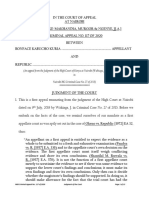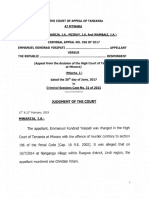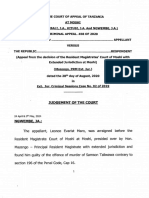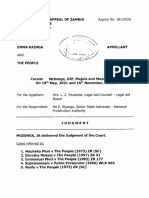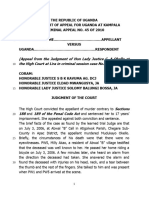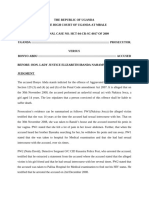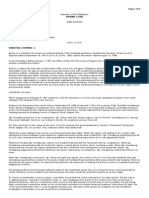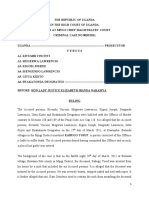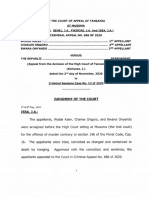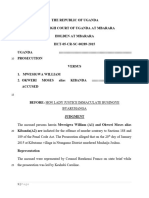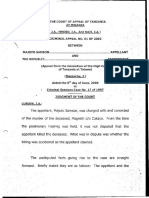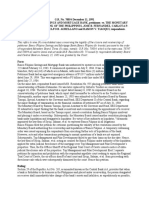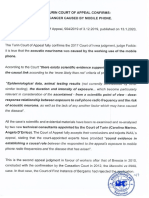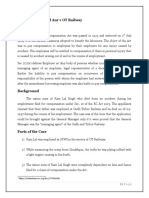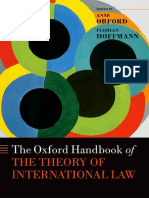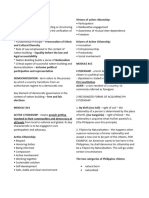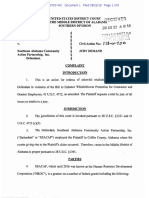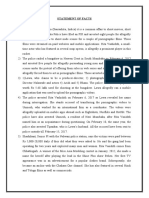Criminal Appeal No. 98 of 2020
Criminal Appeal No. 98 of 2020
Uploaded by
mawphey97Copyright:
Available Formats
Criminal Appeal No. 98 of 2020
Criminal Appeal No. 98 of 2020
Uploaded by
mawphey97Copyright
Available Formats
Share this document
Did you find this document useful?
Is this content inappropriate?
Copyright:
Available Formats
Criminal Appeal No. 98 of 2020
Criminal Appeal No. 98 of 2020
Uploaded by
mawphey97Copyright:
Available Formats
IN THE COURT OF APPEAL
AT NAIROBI
(CORAM: MURGOR, KANTAI & NGENYE, JJ.A.)
CRIMINAL APPEAL NO. 98 OF 2020
BETWEEN
DAVID MWEHA WAWERU.……….………………………...APPELLANT
AND
REPUBLIC….……………………….………………………...RESPONDENT
(An Appeal against the Judgment of the High Court of Kenya at Nairobi
(Lesiit, J.) delivered on 1st October, 2015
in
Criminal Case No. 33 of 2014)
******************
JUDGMENT OF THE COURT
1. The appellant was charged with the offence of murder contrary to
Section 203 as read with Section 204 of the Penal Code. It was
alleged that he murdered Samson Njoroge on 30th June 2013 at
Kariobangi North Location within Nairobi County. During trial, the
prosecution called seven witnesses while the appellant gave a
sworn statement and called no witnesses. Upon trial, he was
convicted as charged and sentenced to death.
NAI Criminal Appeal No. 98 of 2020 Page 1 of 16
2. In considering the issues before us, we remind ourselves that this is
a first appeal, and as a first appellate court, we have to reconsider
the evidence adduced before the trial and re-evaluate it afresh. In
doing so however, we have to bear in mind that we did not have the
advantage of seeing and hearing the witnesses as the trial court did
for which we must give due allowance. In so holding, we are guided
by the case of Okeno v. Republic [1972] EA, 32 where the then
East African Court of Appeal stated on the duty of this Court on first
appeal:
“An appellant on a first appeal is entitled to expect the
evidence as a whole to be submitted to a fresh and
exhaustive examination (Pandya v. R., [1957] E. A. 336) and
to the appellate court's own decision on the evidence. The
first appellate court must itself weigh conflicting evidence
and draw its own conclusions. (Shantilal M. Ruwala v. R.,
[1957] E.A. 570). It is not the function of a first appellate
court merely to scrutinize the evidence to see if there was
some evidence to support the lower court's findings and
conclusions; it must make its own findings and draw its own
conclusions. Only then can it decide whether the
magistrate's findings should be supported. In doing so, it
should make allowance for the fact that the trial court has
had the advantage of hearing and seeing the witnesses, see
Peters v. Sunday Post, [1958] E. A. 424.”
3. We accordingly summarize the evidence adduced before the trial
court as follows: On 30th June 2013 at about 8.00pm, PW1, Simon
Gichuhi Ndung’u was locking up his workshop at Kariobangi Light
Industries when he heard voices on the road 3-5 meters away. PW2,
Francis Maina Kamau, a welder in the same industries was also in
NAI Criminal Appeal No. 98 of 2020 Page 2 of 16
his workshop at the time, when he heard people quarrelling three
doors away, outside a bar. PW1 and PW2 checked and saw four
people, being Samson (hereafter the deceased), the appellant, John
and Nkiri. They overheard the deceased and the appellant, both of
whom were well known to them, arguing over alcoholic drinks. The
deceased was telling the appellant that he had no money to
purchase alcohol. An altercation ensued then PW1 and PW2 saw the
appellant draw a kitchen knife from the right side of his waist and
stab the deceased on the left side of the abdomen and left shoulder.
They heard the appellant saying that he had stabbed the deceased
and that there was nowhere they could take him before walking
away with Nkiri, while John remained with the deceased and
attempted to administer first aid.
4. The following morning around 7.00am, the deceased’s cousin PW3,
Eliud Ngugi Mbugua, received a call from the deceased’s cell
phone number. The caller informed him that the deceased had been
stabbed with a knife. PW3 went to Kariobangi and found the
deceased alive, laying on his side on a veranda. He examined him
and saw stab wounds on his stomach and back. He took him to a
nearby Catholic dispensary from where they were referred to
Mama Lucy Hospital. PW3 rang the deceased’s father, PW4, Joseph
Ngugi Ng’ang’a at 10.00am and informed him about the incident.
PW4 proceeded to Mama Lucy Hospital where he found the
deceased unconscious with injuries on his stomach and shoulder.
He was treated then referred to Kenyatta National Hospital where he
NAI Criminal Appeal No. 98 of 2020 Page 3 of 16
was admitted in the Intensive Care Unit but soon after succumbed
on 2nd July 2013.
5. PW7, Doctor Daniel Zuriel, a consultant Pathologist at Kenyatta
National Hospital performed a post-mortem on the deceased’s body
on 5th July 2013 at the facility’s morgue. The body was identified by
the deceased’s brother, Joseph Ngugi and his father, PW4.
Externally, the deceased had an incision wound penetrating
through the lower abdomen to the intestines. Internally, the
intestines were punctured and had a severe infection with pus. The
lungs had severe pneumonia. PW7 formed the opinion that the
cause of death was a penetrating abdominal injury due to a stab
wound by a sharp object and severe pneumonia. The doctor
explained that due to the stab wound, the deceased developed a
severe infection in the abdomen, which spread to the intestines and
lungs causing pneumonia.
6. The appellant fled the area and was not seen again until 20th April
2014. On that date, PW1 and PW2 saw him entering R.V. Pub in
Kariobangi. PW1 alerted the bar manager who informed the owner,
who in turn contacted the police. PW6, Sgt Abdiasil Mohamed
Noor of Kariobangi Police Station happened to be on mobile patrol
in Kariobangi at the time when he received a call from emergency
number 999 instructing him to proceed to the bar. He went there
and found the appellant surrounded by a large crowd. PW6 arrested
him and took him to Kariobangi Police Station where he was
NAI Criminal Appeal No. 98 of 2020 Page 4 of 16
detained. On the same day, the OCS instructed PW5, PC Richard
Ratemo of the same police station, Crime Branch Section to
investigate the case. PW5 noted that according to their records, the
incident was first reported at the station sometime in 2013 by the
deceased’s father (PW4) on 4th July 2013. The report was that the
deceased was stabbed in the lungs. In executing his mandate, PW5
recorded statements from witnesses and drew a sketch plan of the
scene.
7. In his defense, the appellant denied committing the offence or being
anywhere near Kariobangi when it was allegedly committed. He
stated that on the day in question, he went to his place of work in
Dandora where he worked until 6.00pm then returned home to his
child. Regarding his arrest, he testified that on 20th April 2014, the
police arrested him at about 1:30pm just after he had finished having
his lunch. They falsely claimed that he had a gun yet he had never
owned one. He was taken to Kariobangi Police Station where he was
told that he committed a murder on 30th June 2013. According to him,
this was a fabricated case since he was charged with a different
offence from the one he was arrested for.
8. The trial court having considered and weighed both the prosecution
and appellant’s case, found that the prosecution had proved its case
beyond any reasonable doubt. Being dissatisfied with the
conviction and sentence, the appellant is now before this Court on a
first appeal on the grounds that: the ingredients of the offence of
NAI Criminal Appeal No. 98 of 2020 Page 5 of 16
murder were not established; key and essential witnesses were not
availed by the prosecution; the evidence of identification by
recognition did not pass muster on the test of admissibility; his cogent
defence was dismissed without good ground and the sentence was
harsh, unfair and excessive and did not take into account mitigating
circumstances.
9. The appeal was canvassed by way of written submissions. The
appellant was represented by learned counsel, Mr. Towett while the
respondent was represented by learned State Counsel, Mr.
Muriithi. Mr. Towett submitted that the prosecution did not prove
the offence of murder to the required standard. He argued that the
prosecution failed to establish that the appellant had malice
aforethought and/or that he knew that his actions on the material
night of the incident, would lead to the death of the deceased, as
required under Section 206 (b) of the Penal Code. Counsel argued
that, the appellant may have been intoxicated, reason wherefor he
may not have had the mens rea to conceive or perform any unlawful
act. Further, that the prosecution failed to call a crucial witness,
namely John and Nkiri who were in the company of the deceased
when the deceased was allegedly assaulted. That the evidence of
the two witnesses, if adduced, would have shed more light on what
transpired at the scene, and more particularly that it is not the
appellant who killed the deceased. That the failure to call the said
John and Nkiri no doubt was fatal to the prosecution’s case, which
implied that the conviction of the appellant was based on
NAI Criminal Appeal No. 98 of 2020 Page 6 of 16
unsubstantiated evidence. The appellant relied on the case of Nzuki
vs Republic Criminal Appeal No. 70 of 1991 claiming that it is on all
fours with his case.
10. Counsel also submitted that the case against the appellant was
fabricated as demonstrated by the fact that the witness statements
were recorded months after the incident. He also faulted the trial
court for failing to consider the appellant’s alibi defence which, if it
had been considered, would have exonerated him.
11. As regards sentence, counsel urged that the mandatory death
sentence meted out by the learned trial Judge be set aside in view
of the Supreme Court decision in case of Francis Karioko
Muruatetu & Another vs Republic [2017] eKLR. He urged us to
remit the matter back to the trial court for re-sentencing pursuant to
the said decision.
12. In rebuttal, Mr. Muriithi submitted that malice aforethought was
evident in the fact that the appellant not only had a killer knife but,
stabbed the deceased twice, first in the abdomen then on the
shoulder, which was cold blooded killing without any provocation.
He submitted that the prosecution failed to call John and Nkiri
because they were unavailable. That even if the two never testified,
the evidence of PW1 and PW2 pointed to the fact that no one else
other than the appellant killed the deceased. Further, that there is
uncontroverted evidence that the appellant bragged that he had
NAI Criminal Appeal No. 98 of 2020 Page 7 of 16
stabbed the deceased and no one would do anything about it.
Counsel added that this is not a suitable case for re-sentencing or
varying the sentence as the appellant has not conceded that he
committed the offence. We were urged to uphold both the
conviction and sentence.
13. We have considered the evidence adduced before the trial court,
the respective submissions, authorities relied upon and the law. In
our view, the only issues arising for determination are whether; the
prosecution proved its case against the appellant beyond any
reasonable doubt, the prosecution failed to call crucial witnesses
and whether this Court should exercise its discretion and interfere
with the death sentence imposed on the appellant.
14. As regards the first issue, section 203 of the Penal Code defines the
offence of murder as follows:
“Any person who of malice aforethought causes death of
another person by an unlawful act or omission is guilty of
murder.”
15. From this definition, for a conviction for the offence of murder to be
sustained, the prosecution must prove the fact and cause of the
death of the deceased, that the death was caused by an unlawful act
or omission of the appellant and that the appellant had malice
aforethought when he committed the acts that led to the death of the
deceased.
NAI Criminal Appeal No. 98 of 2020 Page 8 of 16
16. The first issue is not in contestation as, the evidence of PW7, the
Pathologist who conducted the post mortem on the body of the
deceased confirmed the death of the deceased. The deceased
succumbed to injuries at Kenyatta National Hospital’s Intensive Care
Unit on 2nd July 2013. In his opinion, the deceased died from a
penetrating abdominal injury due to a stab wound by a sharp object
and severe pneumonia. Before the post mortem was done, the body
was identified by the deceased’s brother, Joseph Ngugi and his
father, PW4. Having answered the first issue, we now turn on to
whether it is the appellant who caused the death of the deceased.
17. The evidence of PW1 was that he knew the appellant for 3 years
having worked near where he worked. PW2 testified that he knew
the appellant for 5 years as he used to pass by his workshop and find
him in various clubs. Both witnesses were adamant that they saw the
appellant argue with the deceased before retrieving a knife from his
waist and stabbing the deceased twice; they gave a description of
the murder weapon which was a knife with a wooden handle. The
two witnesses thereafter saw the appellant wipe the blood off the
knife on the ground and taunted the deceased that; “I have stabbed
him, but you will not take me anywhere.” The appellant then walked
away leaving the deceased bleeding.
18. From the foregoing, we are satisfied that it was the appellant who
stabbed the deceased, there was light that illuminated the scene
NAI Criminal Appeal No. 98 of 2020 Page 9 of 16
and he was well known to PW1 and PW2, thus there was no error in
his identification as the perpetrator.
19. On whether the appellant had malice aforethought when he killed
the deceased, Section 206 of the Penal Code provides that:-
“Malice aforethought shall be deemed to be established by
evidence proving any one or more of the following
circumstances: -
(a) An intention to cause the death of or to do
grievous harm to any person, whether that person
is the person actually killed or not;
(b) Knowledge that the act or omission causing death
will probably cause the death of or grievous harm
to some person whether that person is the person
actually killed or not, although such knowledge
is accompanied by indifference whether death or
grievous bodily harm is caused or not, or by a
wish that it may not be caused;
(c) An intent to commit a felony;
(d) An intention by the act or omission to facilitate
the flight or escape from custody of any person
who has committed or attempted to commit a
felony.”
20. In the case of Nzuki vs Republic [1993] eKLR, this Court defined
malice aforethought as:
“…a term of art and is either an express intention to kill, as
could be inferred when a person threatens another and
proceeds to produce a lethal weapon and uses it on his
NAI Criminal Appeal No. 98 of 2020 Page 10 of 16
victim; or implied, where, by a voluntary act, a person
intended to cause grievous bodily harm to his victim and the
victim died as the result. See the case of Regina v Vickers,
[1957] 2 QB 664 at page 670. An intention connotes a state of
affairs which the person intending does more than merely
contemplate: it connotes a state of affairs which, on the
contrary, he decides, so far as in him lies, to bring about,
and which, in point of possibility, he has a reasonable
prospect of being able to bring about, by his own act of
volition. See the case of Conliffe v Goodman, [1950] 2 KB
237.”
21. In the same case, the Court went on to state:
“Before an act can be murder, it must be aimed at someone
and in addition it must be an act committed with one of the
following intentions, the test of which is always subjective to
the actual accused:
(i) The intention to cause death;
(ii) The intention to cause grievous bodily harm;
(iii) Where the accused knows that there is a serious
risk that death or grievous bodily harm will ensue
from these acts, and commits those acts
deliberately and without lawful excuse the
intention to expose a potential victim to that risk as
the result of those acts.
It does not matter in such circumstances whether the
accused desires those consequences to ensue or not and in
none of these cases does it matter that the act and the
intention were aimed at a potential victim other than the one
who succumbed.
Without an intention of one of these three types, the mere fact
that the accused’s conduct is done in the knowledge that
NAI Criminal Appeal No. 98 of 2020 Page 11 of 16
grievous harm is likely or highly likely to ensue from his
conduct is not by itself enough to convert a homicide into the
crime of murder. See the case of Hyam v Director of Public
Prosecutions, [1975] AC 55.”
22. In Republic vs Tubere S/O Ochen (1945) 12 EACA 63, the then
Eastern Africa Court of Appeal, set out the following factors to be
considered in determining whether malice aforethought has been
established;
“The nature of the weapon used; the manner in which it was
used; the part of the body targeted; the nature of the injuries
inflicted either a single stab/wound or multiple injuries; the
conduct of the accused before, during and after the
incident.”
23. In this case, we concur with the learned trial Judge that malice
aforethought was established by the prosecution. Prior to the
incident, the appellant was armed with a knife which is no doubt a
dangerous weapon. It is clear that he intended to cause the
deceased grievous harm as he stabbed him in the abdomen where
critical body organs are located. After stabbing the deceased, he
was overheard bragging that no one could take him anywhere. We
find that the trial court did not err when it held that the appellant’s
actions were aimed at the deceased and were intended to cause
death or grievous harm and were deliberately carried out even
though the appellant knew they could cause death. Furthermore,
the appellant’s action of departing from the crime scene and fleeing
from the area are wanting; the incident occurred on 30th June 2013
NAI Criminal Appeal No. 98 of 2020 Page 12 of 16
and the appellant was sighted in the same area on 20th April 2014.
This was almost one year after the incident and we cannot help but
draw an inference that the appellant’s actions are in tandem with the
actions of a guilty mind and not consistent with that of an innocent
person.
24. The appellant has also challenged his conviction on the basis that
the prosecution failed to call crucial witnesses, being John and Nkiri
who were persons in the company of the deceased at the time of the
incident. In Julius Kalewa Mutunga vs Republic [2006] eKLR the
court stated;
“…As a general principle of law, whether a witness should
be called by the prosecution is a matter within their
discretion and an appeal court will not interfere with the
exercise of that discretion unless, for example, it is shown
that the prosecution was influenced by some oblique
motive.”
25. Section 143 of the Evidence Act provides that:
“No particular number of witnesses shall, in the absence of
any provision of law to the contrary, be required for the proof
of any fact.”
26. The circumstances of this case are that, the witnesses who were
called by the prosecution sufficiently established its case. An
adverse inference can only be drawn if the failure to call particular
witnesses weakens the prosecution case. The said John and Nkiri in
our view, would just have adduced repetitive evidence that was
NAI Criminal Appeal No. 98 of 2020 Page 13 of 16
adduced by PW1 and PW2. Although it would have been prudent to
call John and Nkiri, we are unable to conclude that the failure to call
them adversely affected the prosecution case. And neither did the
failure to call them prejudice the appellant in any way. In any case,
the investigating officer, PW5 explained that he was unable to trace
them, we do not think that his failure to record their statements was
influenced by some oblique motive. We find that the prosecution
called a sufficient number of witnesses to prove that the appellant
committed the offence of murder. This ground of appeal has no
merit.
27. As regards learned counsel, Mr. Towett’s submission that the
appellant may have committed the offence due to intoxication, is a
matter we think does not fall for our consideration. We say so
because the appellant did not advance a defence of intoxication and
it was neither an issue brought up during cross examination of any
witness. We hold that the appellant’s defence was properly
considered and dismissed by the learned trial Judge; and on the
same grounds of want of merit, we too, dismiss it accordingly.
28. We are therefore satisfied that the prosecution proved the offence
of murder beyond any reasonable doubt and the appeal against
conviction is unmeritorious.
29. On whether this Court should interfere with the death sentence
imposed on the appellant, it is important to note that this Court can
NAI Criminal Appeal No. 98 of 2020 Page 14 of 16
only interfere with a sentence passed by the trial court if it is
satisfied that the trial court erred in the exercise of its discretion.
In Ogolla s/o Owuor vs Republic, (1954) EACA 270 the East African
Court of Appeal stated thus:
"The Court does not alter a sentence unless the trial Judge
has acted upon wrong principles or overlooked some
material factors”. To this, we would add a third criterion
namely, “that the sentence is manifestly excessive in view
of the circumstances of the case (R - v- Shershowsky (1912)
CCA 28TLR 263)."
30. In the instant appeal, the learned Judge sentenced the appellant to
death as it was the only sentence prescribed by law at the time
under Section 204 of the Penal Code. However, the Supreme Court
in Francis Karioko Muruatetu & another vs Republic [2017] eKLR
found that the mandatory nature of the death sentence was
unconstitutional, as it does not allow the consideration of the
mitigating factors put forth by the accused in order to determine an
appropriate sentence that meet the ends of justice. Death sentence
is however not outlawed as the Supreme Court held that it is still
applicable as a discretionary maximum penalty.
31. A perusal of the trial court’s record reveals that the appellant did not
tender any mitigation for consideration prior to sentencing. We
therefore find that this is an appropriate case for this Court to
intervene and interfere with the death sentence imposed. However,
due to passage of time and in the spirit of reducing case backlog,
NAI Criminal Appeal No. 98 of 2020 Page 15 of 16
we see no reason as to why the matter should be remitted back to
the High Court for mitigation and resentencing.
32. Consequently, this appeal partially succeeds. The appellant’s
appeal against conviction is dismissed. The appeal against sentence
succeeds only to the extent that the death sentence imposed by the
High Court is set aside and substituted with thirty (30) years
imprisonment with effect from the date of arrest, being 20th April
2014.
Dated and Delivered at Nairobi this 26th Day of May, 2023.
A. K. MURGOR
…………………………..
JUDGE OF APPEAL
S. ole KANTAI
…………………………..
JUDGE OF APPEAL
G.W. NGENYE-MACHARIA
……………………………
JUDGE OF APPEAL
I certify that this is a
true copy of the original
Signed
DEPUTY REGISTRAR
NAI Criminal Appeal No. 98 of 2020 Page 16 of 16
You might also like
- Amelor V RTCDocument15 pagesAmelor V RTCJoseph Tiña Ford100% (1)
- NRB Criminal Appeal No. 117 of 2020Document15 pagesNRB Criminal Appeal No. 117 of 2020mawphey97No ratings yet
- Emanuel Kondrad Yosipita VS Republic Crim Appeal No.296 of 2017 Hon - Mwarija, J.ADocument20 pagesEmanuel Kondrad Yosipita VS Republic Crim Appeal No.296 of 2017 Hon - Mwarija, J.AGervas GeneyaNo ratings yet
- Uganda Vs Nakibulle Anor (Criminal Appeal No0021 of 2008) 2016 UGCA 66 (22 December 2016)Document10 pagesUganda Vs Nakibulle Anor (Criminal Appeal No0021 of 2008) 2016 UGCA 66 (22 December 2016)lindakimathiNo ratings yet
- Criminal Appeal No. 126 of 2014 (February 2015) CAT SessionsDocument18 pagesCriminal Appeal No. 126 of 2014 (February 2015) CAT SessionsDATIUS DIDACE(Amicus Curiae)⚖️100% (1)
- Judgment of The Court: 7th & 20th May, 2023Document15 pagesJudgment of The Court: 7th & 20th May, 2023hkiukalaNo ratings yet
- Judgement of The Court: 24 April & 9th May, 2024Document21 pagesJudgement of The Court: 24 April & 9th May, 2024Samwel LawrenceNo ratings yet
- 2020 Tzca 1753Document21 pages2020 Tzca 1753Zuwena KaperaNo ratings yet
- Birembo Sebastian and Anor V Uganda 2002 UGSC 40 (19 December 2002)Document12 pagesBirembo Sebastian and Anor V Uganda 2002 UGSC 40 (19 December 2002)Babirye EstherNo ratings yet
- Anthony Kayaga Mnibhi Vs Republic (Criminal Appeal No 550 of 2019) 2024 TZCA 284 (30 April 2024)Document23 pagesAnthony Kayaga Mnibhi Vs Republic (Criminal Appeal No 550 of 2019) 2024 TZCA 284 (30 April 2024)clarenceNo ratings yet
- Mulwani V The People (Appeal 44 of 2015) 2016 ZMSC 12 (2 February 2016)Document19 pagesMulwani V The People (Appeal 44 of 2015) 2016 ZMSC 12 (2 February 2016)Tamando ZuluNo ratings yet
- Ally Ramadhani Vs Republic 2024 TZCA 962 (3 October 2024)Document26 pagesAlly Ramadhani Vs Republic 2024 TZCA 962 (3 October 2024)Alkado KadoNo ratings yet
- Chamuriho Kirenge Chamuriho Julius vs Republic 2022 Tzca 98 7 March 2022Document26 pagesChamuriho Kirenge Chamuriho Julius vs Republic 2022 Tzca 98 7 March 2022makubisimon3No ratings yet
- Mahuti Chacha Marwa Vs Republic (Criminal Appeal No 500 of 2020) 2024 TZCA 562 (15 July 2024)Document17 pagesMahuti Chacha Marwa Vs Republic (Criminal Appeal No 500 of 2020) 2024 TZCA 562 (15 July 2024)clarenceNo ratings yet
- Judgement of The Court: 07 & 13th December, 2023Document15 pagesJudgement of The Court: 07 & 13th December, 2023jaulanetworkNo ratings yet
- Zamir Rahimu Vs Republic (Criminal Appeal 418 of 2018) 2021 TZCA 102 (9 April 2021)Document10 pagesZamir Rahimu Vs Republic (Criminal Appeal 418 of 2018) 2021 TZCA 102 (9 April 2021)Amiri bashiriNo ratings yet
- Judgment of The Court: 6th & 15th May, 2020Document25 pagesJudgment of The Court: 6th & 15th May, 2020calvinmugwesaNo ratings yet
- Ntirenganya V Uganda (Criminal Appeal No 109 of 2017) 2022 UGCA 70 (3 March 2022)Document16 pagesNtirenganya V Uganda (Criminal Appeal No 109 of 2017) 2022 UGCA 70 (3 March 2022)Daniel ComboniNo ratings yet
- 2002 Ugsc 8 - 0Document38 pages2002 Ugsc 8 - 0Lukwago HabibNo ratings yet
- NKYIFIE v. THE REPUBLIC (1977) 2 GLR 429-442Document7 pagesNKYIFIE v. THE REPUBLIC (1977) 2 GLR 429-442Christiana AbboseyNo ratings yet
- Kulwa Bunzari Bodo Vs Republic 2024 TZCA 1032 (4 November 2024)Document16 pagesKulwa Bunzari Bodo Vs Republic 2024 TZCA 1032 (4 November 2024)isihakaibrahim64No ratings yet
- Amrani Hussein Vs Republic (Criminal Appeal 13 of 2019) 2021 TZCA 136 (22 April 2021)Document23 pagesAmrani Hussein Vs Republic (Criminal Appeal 13 of 2019) 2021 TZCA 136 (22 April 2021)isackadriano44No ratings yet
- NRB Criminal Appeal No. 108 of 2020Document14 pagesNRB Criminal Appeal No. 108 of 2020mawphey97No ratings yet
- Judgment of The Court: 15th & 22nd March, 2024Document9 pagesJudgment of The Court: 15th & 22nd March, 2024Philemon AgustinoNo ratings yet
- A Document Must Be Read Out After Its Admission, EVARIST NYAMTEMBADocument18 pagesA Document Must Be Read Out After Its Admission, EVARIST NYAMTEMBAcalvinmugwesaNo ratings yet
- HC Criminal Division Uganda 2017 18Document12 pagesHC Criminal Division Uganda 2017 18Jackson ZamaNo ratings yet
- 2024 TZCA 390 (30 May 2024)Document18 pages2024 TZCA 390 (30 May 2024)YohanamatayoNo ratings yet
- 2021 Zmca 155Document12 pages2021 Zmca 155lusekelo kamfwaNo ratings yet
- Serwadda Muhammed V Uganda (Criminal Appeal No 82 of 1999) 2000 UGCA 11 (14 August 2000)Document8 pagesSerwadda Muhammed V Uganda (Criminal Appeal No 82 of 1999) 2000 UGCA 11 (14 August 2000)donaldarinaitweNo ratings yet
- Uganda (1967) EA 531) - by His Plea of Not Guilty, The Accused Put in Issue Each and EveryDocument7 pagesUganda (1967) EA 531) - by His Plea of Not Guilty, The Accused Put in Issue Each and EveryAMPIRE ROSETTENo ratings yet
- RWABUGANDEDocument17 pagesRWABUGANDEEDWARD BIRYETEGANo ratings yet
- Supreme Court Uganda 2017 62 - 0 PDFDocument20 pagesSupreme Court Uganda 2017 62 - 0 PDFMusiime Katumbire HillaryNo ratings yet
- PP v. Abatayo Research - Right To Meet The Witness Face To FaceDocument15 pagesPP v. Abatayo Research - Right To Meet The Witness Face To FaceZader GazeNo ratings yet
- Supreme Court Uganda 2018 1Document11 pagesSupreme Court Uganda 2018 1Musiime Katumbire HillaryNo ratings yet
- Awadhi Gaitan Mboma Vs Republic (Criminal Appeal No 288 of 2017) 2020 TZCA 205 (5 May 2020)Document31 pagesAwadhi Gaitan Mboma Vs Republic (Criminal Appeal No 288 of 2017) 2020 TZCA 205 (5 May 2020)sebastianmajaliwaNo ratings yet
- Adongo V Uganda (Criminal Appeal No 45 of 2010) 2014 UGCA 56 (3 December 2014)Document12 pagesAdongo V Uganda (Criminal Appeal No 45 of 2010) 2014 UGCA 56 (3 December 2014)Daniel ComboniNo ratings yet
- Uganda V Masika (Criminal Session Case No 0046 of 2006) 2008 UGHCCRD 7 (26 September 2008)Document8 pagesUganda V Masika (Criminal Session Case No 0046 of 2006) 2008 UGHCCRD 7 (26 September 2008)Ecungu George williamNo ratings yet
- Aggravated Diflement CaseDocument11 pagesAggravated Diflement Caseandrew lubaNo ratings yet
- Sca2024 102Document11 pagesSca2024 102Jesse HanekomNo ratings yet
- Sinkonde V People (Appeal 11 of 2016) 2017 ZMCA 120 (16 March 2017)Document12 pagesSinkonde V People (Appeal 11 of 2016) 2017 ZMCA 120 (16 March 2017)josephkamwale00No ratings yet
- Fappyton Mutuku Ngui V Republic (2014) eKLRDocument7 pagesFappyton Mutuku Ngui V Republic (2014) eKLRProfMcqueenNo ratings yet
- 2005 Ughccrd 2Document13 pages2005 Ughccrd 2Baguma Patrick RobertNo ratings yet
- #11 G.R. No. 223114Document8 pages#11 G.R. No. 223114Fe Myra LagrosasNo ratings yet
- Cacc000318 2000Document44 pagesCacc000318 2000beaglemitch2024No ratings yet
- Katende V Uganda (Criminal Appeal No 21 of 2003) 2014 UGCA 58 (8 August 2014)Document7 pagesKatende V Uganda (Criminal Appeal No 21 of 2003) 2014 UGCA 58 (8 August 2014)Baguma Patrick RobertNo ratings yet
- 13andrada V PeopleDocument4 pages13andrada V PeopleRuab PlosNo ratings yet
- Oroko Wankuru Mniko Vs Republic (Criminal Appeal No 514 of 2019) 2021 TZCA 651 (4 November 2021)Document18 pagesOroko Wankuru Mniko Vs Republic (Criminal Appeal No 514 of 2019) 2021 TZCA 651 (4 November 2021)Amiri bashiriNo ratings yet
- Uganda V Kivumbi 5 Ors (Criminal Case 20 of 2011) 2014 UGHCCRD 89 (12 May 2014)Document12 pagesUganda V Kivumbi 5 Ors (Criminal Case 20 of 2011) 2014 UGHCCRD 89 (12 May 2014)Kavulu FestoNo ratings yet
- 2017 (G.R. No. 227863, People V Ordona y Rendon) PDFDocument8 pages2017 (G.R. No. 227863, People V Ordona y Rendon) PDFFrance SanchezNo ratings yet
- Hamadi Mzamilo Marafya Vs Republic (Criminal Appeal No 603 of 2021) 2023 TZCA 18016 (21 December 2023)Document22 pagesHamadi Mzamilo Marafya Vs Republic (Criminal Appeal No 603 of 2021) 2023 TZCA 18016 (21 December 2023)rehemamdachi19No ratings yet
- Judgment of The Court: 26th September & 3 D October, 2023Document20 pagesJudgment of The Court: 26th September & 3 D October, 2023OTHMAN SWALEHENo ratings yet
- 57 People V GatarinDocument7 pages57 People V GatarinGraceNo ratings yet
- Kifamunte Henry V UgandaDocument11 pagesKifamunte Henry V UgandaEdward BiryetegaNo ratings yet
- Wolde Kaler Others Vs Republic (Criminal Appeal No 686 of 2020) 2024 TZCA 324 (8 May 2024)Document19 pagesWolde Kaler Others Vs Republic (Criminal Appeal No 686 of 2020) 2024 TZCA 324 (8 May 2024)clarenceNo ratings yet
- Mohamed Said Rais Vs Republic 2022 Tzca 479 26 July 2022Document12 pagesMohamed Said Rais Vs Republic 2022 Tzca 479 26 July 2022Pamsha JosephNo ratings yet
- Uganda V Mwesigwa and Anor (HCT 00 SC 289 of 2015) 2020 UGHC 188 (17 December 2020)Document14 pagesUganda V Mwesigwa and Anor (HCT 00 SC 289 of 2015) 2020 UGHC 188 (17 December 2020)Ecungu George williamNo ratings yet
- Andrada v. PeopleDocument4 pagesAndrada v. PeopleDelia PeabodyNo ratings yet
- Nehememia Rwechungura Vs Republic (Criminal Appeal 71 of 2020) 2021 TZCA 704 (30 November 2021)Document14 pagesNehememia Rwechungura Vs Republic (Criminal Appeal 71 of 2020) 2021 TZCA 704 (30 November 2021)Amiri bashiriNo ratings yet
- 2004 Tzca 5 - 1Document13 pages2004 Tzca 5 - 1HASHIRU MDOTANo ratings yet
- G.R. No. 175023 July 5, 2010 Giovani Serrano Y Cervantes, Petitioner, People of The Philippines, RespondentDocument10 pagesG.R. No. 175023 July 5, 2010 Giovani Serrano Y Cervantes, Petitioner, People of The Philippines, RespondentAprilleMaeKayeValentinNo ratings yet
- Aids to Forensic Medicine and ToxicologyFrom EverandAids to Forensic Medicine and ToxicologyNo ratings yet
- WEEK 4-BANCO FILIPINO SAVINGS AND MORTGAGE BANK vs. THE MONETARY BOARDDocument3 pagesWEEK 4-BANCO FILIPINO SAVINGS AND MORTGAGE BANK vs. THE MONETARY BOARDKrizzle de la PeñaNo ratings yet
- 001 Application For Notarial CommissionDocument4 pages001 Application For Notarial CommissionSam LagoNo ratings yet
- Catoosa Superior SUCV2022000346 ComplaintDocument33 pagesCatoosa Superior SUCV2022000346 ComplaintWTVCNo ratings yet
- Turin Verdict ICNIRP Judgment SUMMARY of The Turin Court of Appeal 9042019 en MinDocument7 pagesTurin Verdict ICNIRP Judgment SUMMARY of The Turin Court of Appeal 9042019 en MinJessica Learmond-CriquiNo ratings yet
- Philippine Guardians Brotherhood, Inc. vs. COMELECDocument12 pagesPhilippine Guardians Brotherhood, Inc. vs. COMELECAlexander GreatNo ratings yet
- SourceDocument21 pagesSourceismailnyungwa452No ratings yet
- Bajinath V OT Railways - Case AnalysisDocument4 pagesBajinath V OT Railways - Case AnalysisMaahiNo ratings yet
- Probation Rules (Drugs Cases)Document12 pagesProbation Rules (Drugs Cases)DianneNo ratings yet
- Orford Et Al, The Oxford Handbook of The Theory of International LawDocument1,109 pagesOrford Et Al, The Oxford Handbook of The Theory of International LawCatalina100% (2)
- The Practice of Law Is A Noble ProfessionDocument3 pagesThe Practice of Law Is A Noble ProfessionKen TuazonNo ratings yet
- People v. Maqui Case DigestDocument1 pagePeople v. Maqui Case Digestalex_austriaNo ratings yet
- Reviewer Sa Soc 003 Uwu UwuDocument12 pagesReviewer Sa Soc 003 Uwu Uwuponytown184No ratings yet
- Prison ActDocument23 pagesPrison ActJacK[EvoX]No ratings yet
- Resins, Inc. v. Auditor GeneralDocument1 pageResins, Inc. v. Auditor GeneralGyrsyl Jaisa GuerreroNo ratings yet
- Accused Can Plead Guilty at Any Stage of Trial - Indian Law DatabaseDocument2 pagesAccused Can Plead Guilty at Any Stage of Trial - Indian Law DatabaseRana Shaukat AliNo ratings yet
- Nikola v. Tesla - AnswerDocument35 pagesNikola v. Tesla - AnswerSarah BursteinNo ratings yet
- Case #8 Guillermo Villanueva Representing United Coconut Planters Life Insurance Corporation (Cocolife) Vs Atty. Bonifacio Alentajan A.C. No. 12161, June 08, 2020Document2 pagesCase #8 Guillermo Villanueva Representing United Coconut Planters Life Insurance Corporation (Cocolife) Vs Atty. Bonifacio Alentajan A.C. No. 12161, June 08, 2020Harlene HemorNo ratings yet
- 4e Impact of Forensic Science Evidentiary Value in DNA Test, Narco-AnalysisDocument20 pages4e Impact of Forensic Science Evidentiary Value in DNA Test, Narco-AnalysisRandom IntrigueNo ratings yet
- Skull Shaver v. Ideavillage - Opinion On Summary JudgmentDocument22 pagesSkull Shaver v. Ideavillage - Opinion On Summary JudgmentSarah BursteinNo ratings yet
- Counter AffidavitDocument4 pagesCounter AffidavitDennyTemplonuevoNo ratings yet
- Judgment of RD Dhanuka On (FSI) With CitationDocument34 pagesJudgment of RD Dhanuka On (FSI) With CitationSandeep NirbanNo ratings yet
- Alabama LawsuitDocument8 pagesAlabama LawsuitSteveNo ratings yet
- Case 32Document2 pagesCase 32Dianne Macaballug100% (1)
- Some Pointers in Civil ProcedureDocument6 pagesSome Pointers in Civil ProcedureSara Andrea SantiagoNo ratings yet
- Takings Exclusivity and Speech - The Legacy of PruneYard V RobinsDocument36 pagesTakings Exclusivity and Speech - The Legacy of PruneYard V Robinsamydaniels99No ratings yet
- Moot 1Document3 pagesMoot 1Fidha AshrafNo ratings yet
- Partition SuitDocument6 pagesPartition SuitTejasvini KhemajiNo ratings yet
- TESTATE ESTATE OF JOSE EUGENIO RAMIREZ vs. RamirezDocument2 pagesTESTATE ESTATE OF JOSE EUGENIO RAMIREZ vs. RamirezVloudy Mia Serrano PangilinanNo ratings yet
- Crim Law Mitigating Circumstances CasesDocument5 pagesCrim Law Mitigating Circumstances Caseszennichan07No ratings yet

